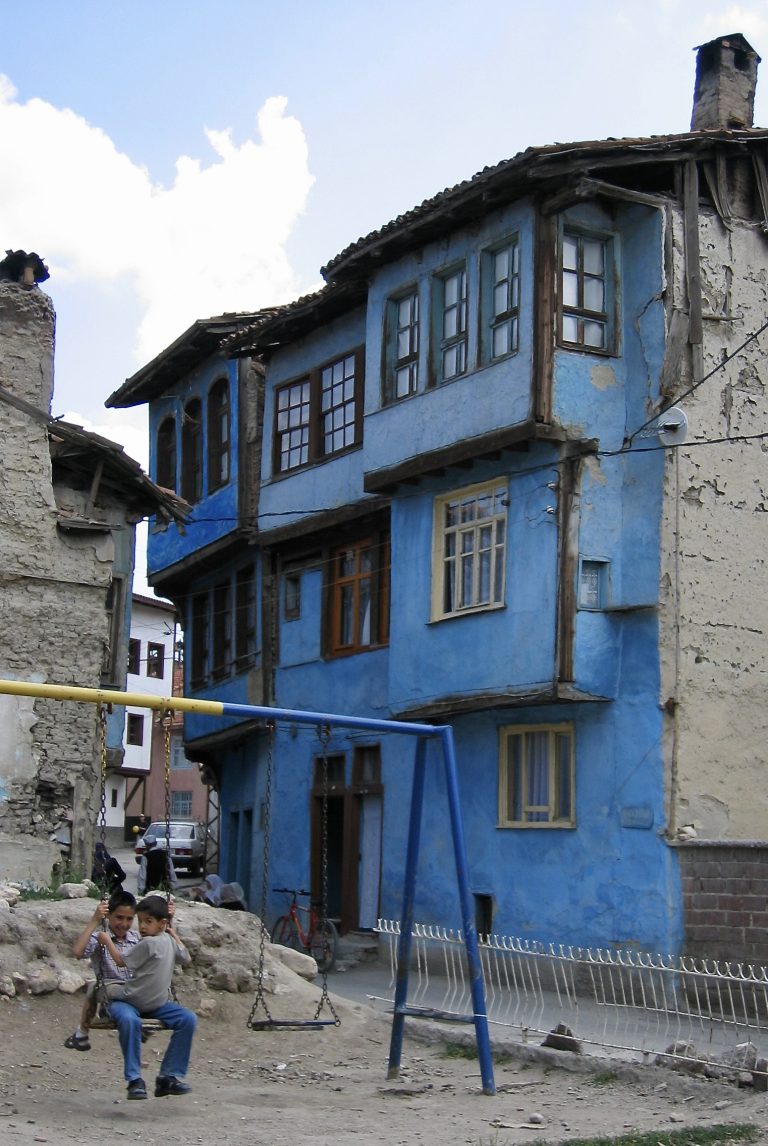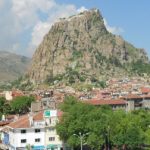Turkey’s ceramics capital Population: 282,000
 Old name: Cotyaeum (Roman)
Old name: Cotyaeum (Roman)
Favourite son: Ahmet Yakupoğlu (artist, flautist)
Like İznik, Kütahya is a town that is best known for its ceramics. Unlike İznik, however, Kütahya is mainly known for its pottery, rather than its tiles. It’s the type of pottery that turns up in tourist shops all over Turkey but the merchants of Kütahya have been sensible in their planning, and so, alongside the routine tourist tat, they also produce fine quality porcelain of the sort that graces many Turkish homes.
Kütahya has the air of a town that is doing very well for itself, a general impression that is heightened by the fact that the usual high-rise development that so scars most Turkish towns is here kept well to the outskirts.
Even if you’ve just flown into Turkey and know nothing about the pottery connection, it would be hard to miss it once you get here. The huge pottery showrooms aside, the main square is dominated by a fountain with an outsized vase in the middle of it, while the municipality building is encased in colourful tiles. Ditto the Gül Palas Hotel just across the way and, behind it, the late 19th-century Eski Hükümet Binası (old government building), now the Adalet Sarayı (Palace of Justice). 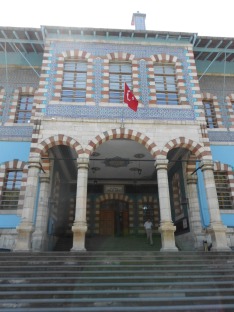 Eski Hükumet Binası (modern Adalat Sarayı)
Eski Hükumet Binası (modern Adalat Sarayı)
But Kütahya has a great deal more to offer than the pottery connection. A great deal of the town’s old Ottoman fabric still survives intact along with a fine collection of interesting mosques and medreses, one of them housing an archaeological museum. The bazaar is also well worth an hour or two of anyone’s time and the City Museum in renovated Germiyan Sokağı is one of a new breed of modern showcases for Turkish history.
Around town
Your best bet is to head straight for the Ulu Cami which lies at the heart of an area of lovely old Ottoman housing. The current Ulu Cami itself is not particularly old, although the original building dated back to 1410. However, it’s extremely popular with local worshippers — no matter when you pass it, you’re bound to find plenty of men washing their feet in the fine ablutions fountain, which incorporates carved marble panels that look as if they’ve strayed from the old Roman town of Cotyaeum.
The Ulu Cami is sandwiched between the town’s two main museums (closed Mondays). The Tile Museum, a temple to all things ceramic, is housed inside what was once the İmaret Cami and still contains the delightful turquoise-tiled tomb of Yakup Bey (r. 1390-1409), a scion of the rough and ready Germiyan family who governed this part of Western Anatolia in the period after the collapse of the Selçuk Empire.
The Kütahya Archaeology Museum is housed inside the more austere Vacidiye Medrese, once a science school and observatory which was built for another of the Germiyans in 1314. The exhibits are of only passing interest, except for a wonderful reconstructed sarcophagus which was found at nearby Aizanoi (modern Çavdarhisar), and shows single-breasted Amazon warriors enthusiastically combating the Greeks.
What was briefly the home of the Hungarian revolutionary Lajos Kossuth (1802-94) stands a little way uphill from the Tile Museum. Dreaming of freeing his country from the Habsburg yoke, Kossuth staged an uprising in 1849. Unfortunately the Russians sided with the Austrians against him and Kossuth was forced to flee to Kütahya where he stayed from 1850 to 1851. Even if you know nothing about Hungarian history, it’s still worth popping into his house to get an idea of the style in which wealthy locals of the mid-19th century would have lived. The view over the garden and statue of Kossuth to the hills is especially appealing.
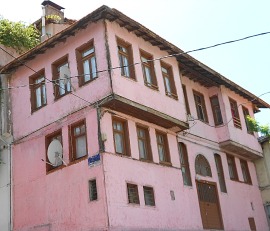 Typical Ottoman house in KütahyaIt’s worth wandering back to the Ulu Cami along Cumhuriyet Caddesi which is lined with old Ottoman houses, some of them on the slippery path to extinction but a number still in fairly good shape.
Typical Ottoman house in KütahyaIt’s worth wandering back to the Ulu Cami along Cumhuriyet Caddesi which is lined with old Ottoman houses, some of them on the slippery path to extinction but a number still in fairly good shape.
In one of them, the Kütahya Konağı, the different rooms of what was once a private house have been converted into individual dining rooms serving a menu with plenty of local twists. On the ground floor a circular table is set up around what was originally the old well. Upstairs, you can take your çay in a room in which Prime Minister Adnan Menderes once stayed for three days although you might want to pass on the opportunity to dress up in Ottoman gear while doing so.
Not far from the Ulu Cami is the restored 14th-century Dönenler Cami, named after the whirling dervishes who used to perform their semas in a circular prayer area which comes complete with viewing gallery. You won’t be able to miss it as there’s a statue of a whirling dervish in the middle of the road in front of it.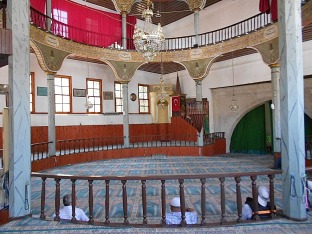 Dönenler Cami
Dönenler Cami
Directly north of the Dönenler Cami lie the narrow streets that host Kütahya’s bazaar. It’s possible to pass a very pleasant couple of hours poking about here, stumbling upon several minor medieval mosques and the remains of some imposing old market buildings. The Büyük and Küçük Bedestens have both been restored and show off patches of original frescoed decoration. Helvacı Sabri has been in the business of sweet-making here since 1938 and is still going strong. Keep an eye out and you will also spot women who have come in from surrounding villages to do their shopping. They wear a distinctive mustard-coloured headscarf which is striped with thick bands of red.
Eventually you will probably stumble upon Germiyan Sokağı, the first street of old Ottoman houses to have been given a proper makeover. It’s here that you will find Kütahya’s first boutique hotel, rather unexpectedly called the Ispartalılar Konağı (Mansion of the Ispartan Family) as well as the new Kent Müzesi (City Museum) which is mainly devoted to the town’s more recent history. It’s well worth a quick visit although the labelling is all in Turkish.
When it comes to picking somewhere for dinner the choice should be obvious. As you explore the back streets of Kütahya, you will catch frequent glimpses of the circular towers of the fine old castle crowning the hill above it. Dating back to Byzantine times (it was built in the 8th century, then restored in the 12th), the castle was restrengthened in the reign of Sultan Mehmed II. It’s dominated by the rather unexpected Döner (Revolving) Restaurant which offers the finest views over the city. And, yes, it does revolve — occasionally!
 Yeşil CamiOf the towns other mosques it’s particularly worth looking out for the richly decorated Yeşil Cami (Green Mosque) that was commissioned in 1905 by Fuat Paşa, the same local governor responsible for the Hükümet Binası and Adalet Sarayı; and for the Hisarbey (Saray) Cami, built in 1487, which turns out to contain a wealth of tiles and early Ottoman medieval painted woodwork including a booth in the gallery for when the local emir paid a visit.
Yeşil CamiOf the towns other mosques it’s particularly worth looking out for the richly decorated Yeşil Cami (Green Mosque) that was commissioned in 1905 by Fuat Paşa, the same local governor responsible for the Hükümet Binası and Adalet Sarayı; and for the Hisarbey (Saray) Cami, built in 1487, which turns out to contain a wealth of tiles and early Ottoman medieval painted woodwork including a booth in the gallery for when the local emir paid a visit.
The turquoise-tiled, octagonal Çinili Cami was built in 1973 to designs drawn up by the local artist and ney player, Ahmet Yakupoğlu (1920-2016). Unfortunately it was found to be at risk from earthquake damage and reopened in 2023 after being completely rebuilt.
Evliya Çelebi For lovers of trivia it’s worth noting that the great Ottoman travel writer Evliya Çelebi (1611-82) was from a Kütahyalı family. Unfortunately the statue of him that used to stand in the town centre has migrated out to the Eskişehir road and what purports to be a museum in his memory turns out to be a brand-new “Ottoman” house containing nothing more enlightening than a copy of his Seyahatname (Book of Travels) in Turkish. There is also a library in his name opposite the Ulu Cami (?) but that too was closed on my most recent visit.
Eating
Kütahya is hardly a hotbed of fine dining. On a 2023 visit I was directed to the Fesleğen in the town centre (Merkez Sokak No 29) which offers a range of open and closed pides from the Black Sea in a cheerful and clearly popular restaurant. Otherwise, the restaurant at the Hilton Garden Inn offers made-to-order dinners which would probably be excellent if the breakfasts are anything to go by.
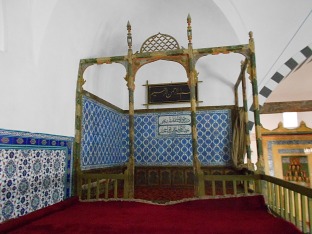 Hisarbey Cami
Hisarbey Cami
Sleeping
If you don’t want to stay in the centre of Kütahya it’s worth knowing that there is a thermal resort nearby at Emet.
Transport info
There are regular buses from İstanbul and Eskişehir (70km) to Kütahya whence there is also regular transport to the ruins at Çavdarhisar.
Alternatively, you could take a fast train to Eskişehir and then catch a bus to Kütahya.
Day trip destinations
Read more about the Yeşil Cami: http://www.turkeyfromtheinside.com/blogbloggingaboutturkey/entry/78-k%C3%BCtahya-s-forgotten-pasha.html
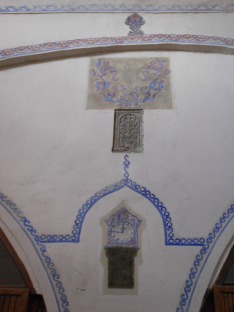 Restored murals in Küçük Bedesten
Restored murals in Küçük Bedesten
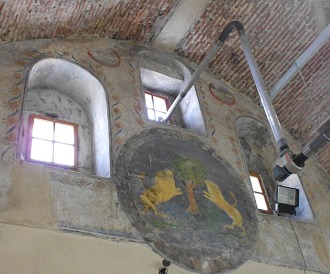 Mural in restored Büyük Bedesten
Mural in restored Büyük Bedesten
